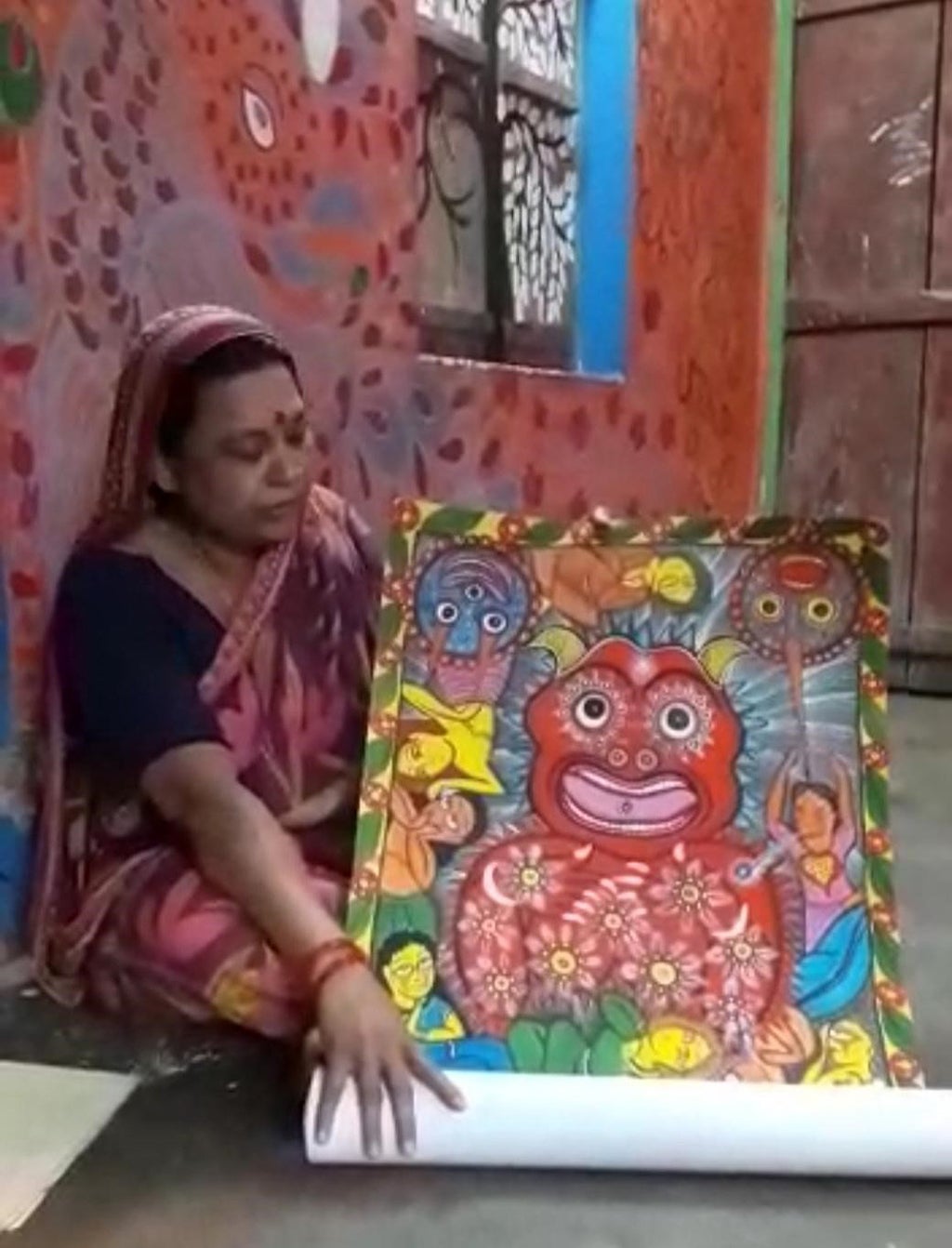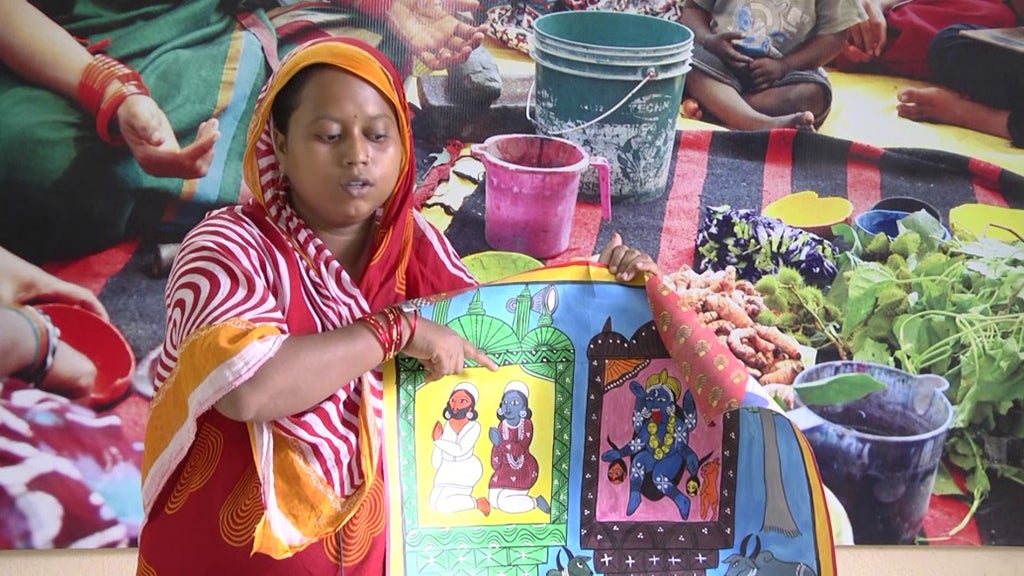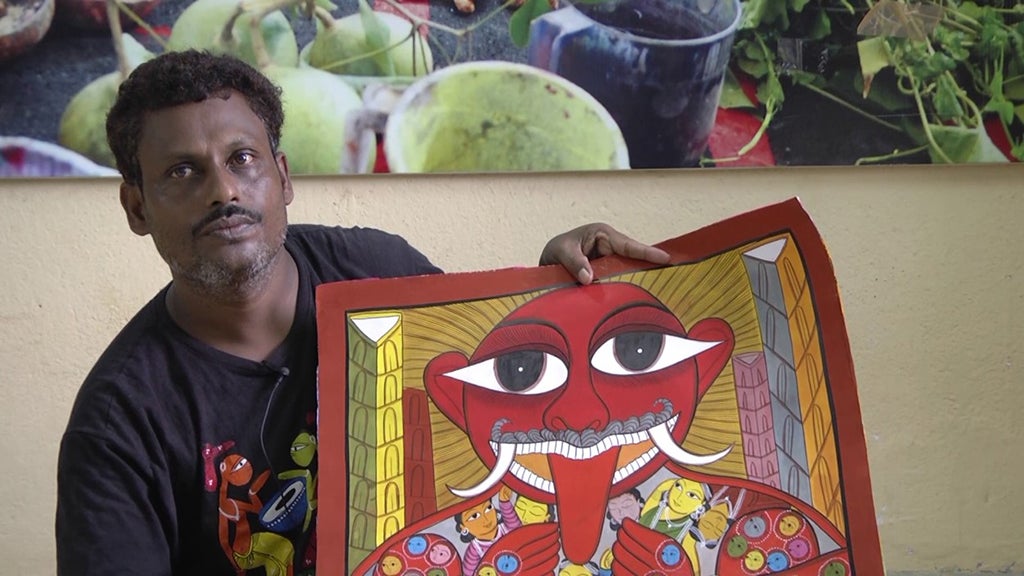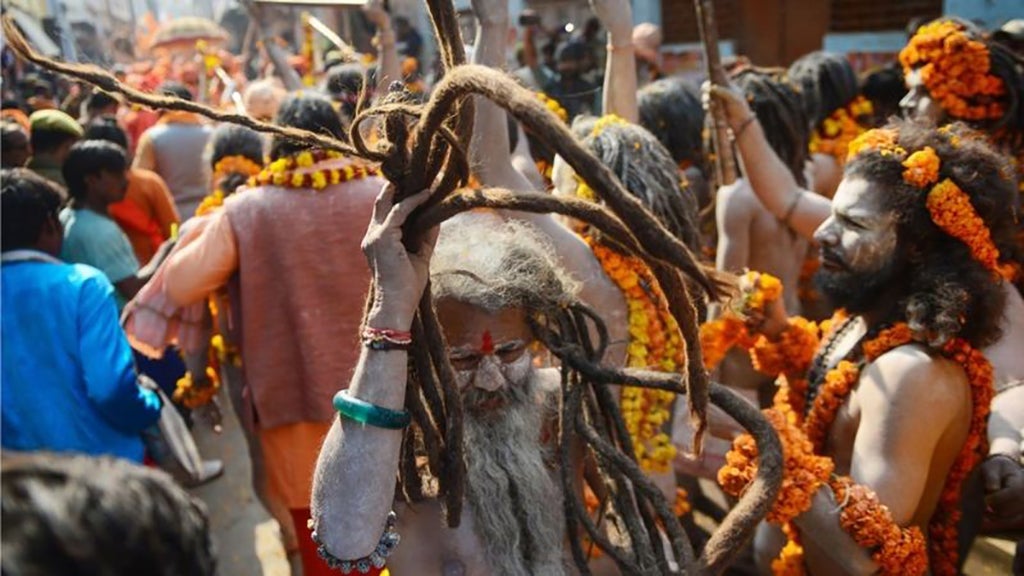Coronasur, Folk Epistemologies, and the Pandemic
contributed by Anjali Gera Roy, Banhi Chakraborty, Swatee Sinha, Trina Maitra, and Soumya Acharya, 2 December 2020

Figure 1. Bapi Chitrakar’s pata. Photo Credit: Soumya Acharya
Introduction
Foucault’s conceptual framework of long history seeks to understand change in terms of movements of slow accumulation and dissipation, as a rhythmic cycle of checks and balances. This slow movement of “material civilization,” where the concept of a rupture or discontinuity (2010: 3-4) plays a critical role in bringing about a paradigm shift, is reflective of the mythopoetic underpinnings of folk epistemologies in their understanding of natural calamities and disease. Disease is interpreted in these epistemologies as a manifestation of cosmic disharmony, and hence requires strategies of appeasement to assuage the anger of the gods and the goddesses. As David Arnold points out, epidemics, because of their scale, nature, and general resistance to conventional cure, are often looked upon as the manifestation of the wrath of gods (1986: 118-151).
Patuas (scroll-painters), a community of roving performers who narrate stories revolving around Hindu mythology and contemporary social issues through their scroll-paintings, have been proactive in reconstituting an aetiology of the COVID-19 pandemic through the visual tropes of traditional scroll-painting. Their understanding of the virus remains deeply embedded within a collective epistemology invested in their everyday ritual practices and belief systems, which draw from both Hindu and Islamic religions. The viral intervention becomes an instantiation of a rupture or break that unleashes dark inscrutable forces and unsettles reified patterns of existence in the process. Focusing on the interruptive and destabilizing properties of the virus and its absorption within a folk epistemology, this article examines the visibilization of the microscopic dimensions of the coronavirus through a folk iconography gesturing towards a biocultural and biosocial interpretation. The article is based on the project “Folk Artists in the Time of Coronavirus” awarded by IIT Kharagpur in which twenty established and emerging Patua artists were commissioned to represent the novel coronavirus.
Scroll depictions
The teeming visual iconography of the scrolls enfolds multiple dimensions of the COVID-19 crisis, spanning the global and the local; in the process, it stages an encounter between the micro-histories of a nomadic band of scroll painters and the macro-dimensions of a global health emergency. As a succession of slides, a scroll narrative is comprised of disparate tableaus that engender a rich cluster of mythopoetic associations.

Figure 2. Sushama Chitrakar with her pata. Photo Credit: Soumya Acharya
Literally, the word asura (corresponding to the Zoroastrian ahura as in Ahura Mazda) which simply meant mighty or indomitable, underwent drastic semantic changes and accrued acutely negative connotations over the ages to denote demons, or equally powerful enemies of the gods (Thundy 1999).

Figure 3. Sandhya Chitrakar with her pata, Photo Credit: Soumya Acharya
Wide, piercing eyes, unkempt hair, predatory fangs, rapacious tongue, and somber hues – the graphic representation of the virus assails all aesthetic coordinates and evokes the imagery of the asura as a chaotic force of supernatural proportions. The virus, too, like an asura, has jeopardized the status quo and exposed the fault-lines of the apparent human command over every knowledge-system in its resistance to be assimilated within the interpretive parameters afforded by medico-scientific discourses. When asked about her choice of portraying the virus as an asura, Swarna Chitrakar, one of the patuas, replied, “Like an asura, the virus, too has held us all in its tight grasp. It does not remain pacified with just one sacrifice. The greed for new victims keeps multiplying. I have deliberately painted the virus in red because as a community we are trying to raise an alarm against its potent threat.”

Figure 4. Swarna Chitrakar with her pata. Photo Credit: Soumya Acharya
The looming sense of uncertainty, the escalating death toll, and social paralysis have warped the contours of normalcy and crippled the economy. As Manimala Chitrakar states, “the virus, like an asura has ravaged everything – from lives to livelihoods. With the might of a mammoth, it has uprooted everything. We have heard tales from our forefathers about asuras and their shape-shifting abilities. The virus, too, is constantly changing its strains, making it impossible to pit it against our pre-existing knowledge frames.” The horrifying aspect of the virus has been linked with the asura image by more than half the patuas (Swarna Chitrakar, Manu Chitrakar, Manimala Chitrakar, Bapi Chitrakar, Laila Chitrakar, Sushama Chitrakar, Yakub Chitrakar, Khaleda Chitrakar, Sayeda Chitrakar, Hajara Chitrakar, Sandhya Chitrakar to name a few) commissioned for the project. Other modalities of representation have borrowed from the rich mythological literature devoted to Hindu gods and goddesses portraying the virus as a scourge, a pestilence personified in the figure of a demon locked in a cosmic war with restorative and divine energies. Some of the patas are punctuated with images of the Hindu goddess, Kali, a dark reservoir of chaotic energy. In one particular pata, we also find the presence of the Kalki Avatar – the destroyer and savior of humankind - in the face of an approaching apocalypse.

Figure 5. Khaleda Chitrakar, with her pata. Photo Credit: Soumya Acharya
The virus has thus been represented variously as an inscrutable entity belonging to the realm of cosmic forces, an insidious presence that eludes human understanding as well as the scapegoat, which absorbs the negative affect in the process of purging the community. The patas on coronavirus seem to invoke the image of the evil incarnate – in all its hideous manifestations. It also attains the stature of a scapegoat – a site where a community dumps all its undesirable elements (Girard, 1982).

Figure 6. Bapi Chitrakar, with his pata. Photo Credit: Soumya Acharya
Works Cited
Arnold, D., “Cholera and Colonialism in British India”, Past & Present, Vol. 113, 1986, p. 118-151, url: https://www.jstor.org/stable/650982, accessed on Nov. 8, 2020.
Foucault, M, The Archaeology of Knowledge, New York: Vintage Books, 2010.
Girard, R., The Scapegoat, Maryland: John Hopkins University Press, 1982.
Thundy, Z., “The Indian Vampire: Nomen et Numen”, ed., Leonard G. Heldreth and Mary Pharr, The Blood is the Life : Vampires in Literature, Ohio: Bowling Green State University Popular Press, 1999.
Disclaimer: The views and opinions expressed in this article are those of the authors and do not necessarily reflect the position of the blog editorial team or the Asia Research Institute.
South Asia | Southeast Asia | East Asia | Other Places | Hinduism | Buddhism | Islam | Christianity | Other Religions
Anjali Gera Roy is Professor in the Department of Humanities and Social Sciences, Indian Institute of Technology Kharagpur and the principal investigator of the project entitled “Folk Artists in the Time of Coronavirus”.
Banhi Chakraborty, former Asst. Professor in the Department of Architecture & Regional Planning, IIT Kharagpur, is the co-investigator of the project.
Swatee Sinha and Trina Maitra are PhD scholars in the Department of Humanities & Social Sciences.
Soumya Acharya is a final year undergraduate student in IIT Kharagpur and member of the research team.
Other Interesting Topics
Chants of Synchrony
As women in North Indian states gather to worship and sing to please ‘Corona Mai’ (Coronavirus Goddess), onlookers might question the motivation to engage in effortful and ritualistic practices that do not involve immediate payoffs. These women are not alone in reverting to ‘socially scripted’ behaviors in the face of ecological threats, such as the presence of a virus. We have had numerous other examples in our history...
The Pandemic and Shifting Practices of Islamic Charity
The Covid-19 pandemic has led to a shift in the practices of Muslim communities and Islamic charitable organizations in Indonesia. The pandemic not only has forced them to improve their fundraising methods but has also encouraged a jurisprudential review in charitable management...



